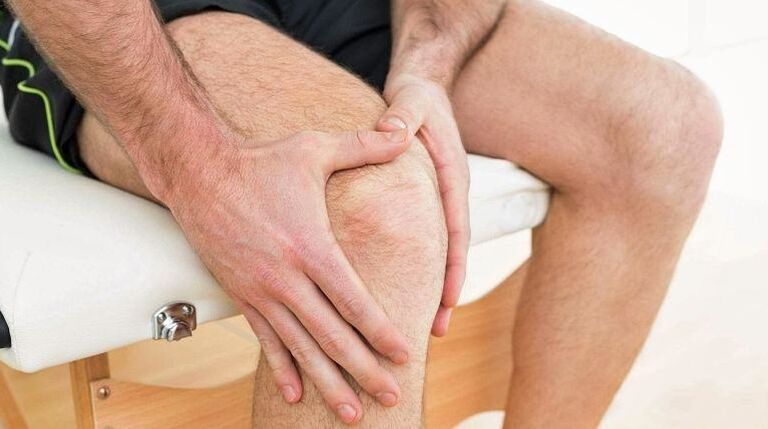
Everyone experiences knee pain from time to time. This can be the result of a sudden movement or a symptom of a progressive pathology. The knee joint is the largest and most anatomically complex element of the musculoskeletal system. It accounts for up to 80% of body weight, leading to increased physical activity and risk of injury. A large number of capillaries, nerve fibers and muscle tissue make every injury, no matter how small, extremely painful. Injured nerves cause an infectious-inflammatory process, which is accompanied by swelling, discoloration of the skin and increased local temperature.
With progressive progression, the joint itself, intra-articular fluid and connective tissue are drawn into the pathological condition, which can lead to serious consequences - the development of arthritic diseases. A general understanding of the anatomical structure of the knee joint will help you understand which element can cause pain and what measures should be taken to eliminate pain.
Anatomical construction
The front zone of the joint is formed by the patella, in simpler language - the patella. It is connected to the thigh muscle quadriceps (fascicle), which continues in the patellar ligament and, in general combination, forms a ligament apparatus consisting of the following types of fascia:
- lateral branches from tibia (small and large);
- posterior support nodes - crescent, dorsal, median and lateral;
- Articular transverse and cruciate ligaments of the knee.
The cruciate ligaments are the most prone to injury - a sharp movement, a strong rotation, a fall with subluxation lead to ruptures of the interminimal joints.
Ribbons are divided into two types:
- Anterior - They have the function of stabilizing the ankle and especially preventing excessive forward displacement. They originate from the back of the great femur, cross the posterior ligaments in the knee cavity, and insert at the notch between the anterior projections of the tibia.
- Rear - Prevent the lower leg from moving backwards. They begin at the anterior superior portion of the femur, traverse the articular cavity, and end between the dorsal projections of the tibia.
There is cartilage on the surface of the joint bones. At the junction of the tibia and femur are menisci - a type of joint lining that plays a shock-absorbing and stabilizing role.
There are several synovial bags (from three to five) in the knee joint, which provide natural lubrication:
- above the kneecap;
- hollow of the knee deep;
- between the tendons in the long thigh muscle;
- subcutaneous patella;
- in the recess below the knee joint.
Thanks to the knee, a person can take a step, bend and extend within the limits indicated by the ligaments.
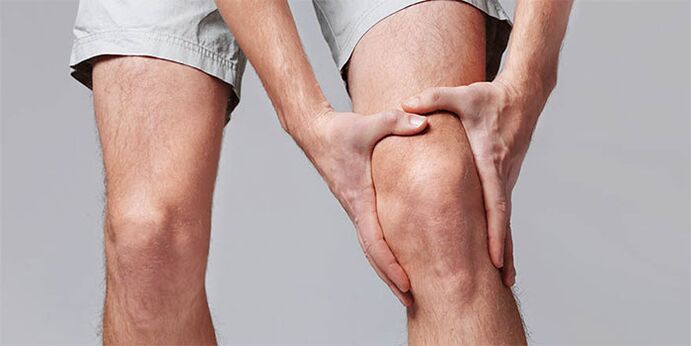
causes of pain
Inflammation can develop in the following structures:
- Cartilage;
- common shell;
- synovial fluid;
- shin bones;
- muscles and tendons surrounding the joint;
- ligament apparatus;
- blood vessels, veins, arteries;
- subcutaneous fat;
- Epidermis.
The most common causes of knee pain are:
- Osteoarthritis is the cause of more than 50% of knee pain cases. It is characterized by slow, gradual destruction of hyaline cartilage. For a long time it can be asymptomatic, and in the second stage it can greatly aggravate. Pain in the knee joint arises from growing osteophytes affecting nerve endings;
- Arthritis is an inflammatory pathology that occurs in an acute form. It can be either an independent disease - spondylitis, or a complication of other joint pathologies - arthrosis, rheumatism, etc. Arthritis is characterized by severe pain, accompanied by swelling and redness;
- Osteochondritis - articular cartilage becomes inflamed over time with degenerative arthrosis, mechanical injuries;
- Periarthritis is a disease that occurs against the background of obesity (more common in women). The pathology affects the tendons, muscles, and subsequently passes to the shell of the knee joint. The pain is moderate and pulling (like a sprain).
- Chondromatosis is the formation of nodules on the tissue of hyaline cartilage that eventually spread throughout the capsule of the knee joint. In this case, there is a pinching of soft tissues with a large number of nerve cells. Because of this, the knee hurts constantly, even during rest.
- Bursitis - the synovial capsule of the knee joint rarely inflames itself, only as a result of injuries or complications of collateral joint diseases, hence the pain.
- Cellulite - subcutaneous fatty tissue can cause pain only with closely spaced foci of concomitant diseases. Purulent arthritis, soft tissue abscess can cause inflammatory and painful processes in the protective layer.
- Dermatitis - the epidermis is affected in infectious pathologies (eczema, erysipelas, psoriasis) or allergic reactions to external stimuli.
- Osteomyelitis – the bone marrow becomes inflamed by bacteria that have invaded the jelly-like body along with the lymph flow. It can also be the result of open injuries or a complication of surgical procedures.
- Synovitis - the capsule of the knee joint is most often affected in elderly people over 55 years old as a result of rheumatism or other chronic diseases. At a young age, you can get sick from a serious injury.
Types of pain depending on localization
Diseases that provoke the development of negative processes also form the type of pain:
- Intense, unbearable pain - reactive arthritis, meniscus and tendon tears, bursitis in the acute stage;
- Tolerable, but constant pain - synovitis, bursitis in the initial degree;
- Pinching pain - gonarthrosis, arthrosis;
- Vibrating - degenerative arthrosis at the stage of joint deformation;
- Acute, burning pain - compression of the sciatic nerve, bone tuberculosis;
- stinging - osteoporosis, progression of inflammation of the synovial bag, exacerbation of chronic meniscus injury;
- spasms - inflammation in the soft tissues of the knee joint, muscles and tendons;
- Shooting pain - damage to nerve roots.
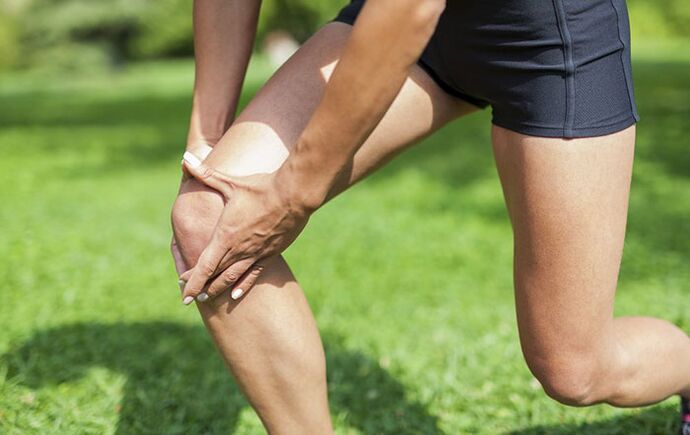
diagnostic measures
If you have severe pain in the knee joints, then you should not postpone a visit to the doctor, hoping that "everything will pass. "Early diagnosis ensures successful treatment and prevents the development of more serious processes that can lead to irreparable damage to health and quality of life. For an initial consultation, you should contact a therapist. After a standard examination, he decides on treatment (which is the case in 70% of cases of knee pain complaints) or prescribes a comprehensive laboratory and hardware examination with the involvement of highly specialized specialists.
Ongoing, suspicious pains are examined in several directions:
- Traumatology: if there is a suspicion of arthrosis, congenital or acquired dysplasia, joint fracture, dislocation, dislocation, X-ray, MRI, ultrasound, liquid biopsy in the synovial sac is prescribed to find out where the pain in the knee joint is coming from.
- Surgery: cysts under the patella, thrombosis, arthritis with purulent formations, tears in the tendons, menisci, ligaments, stones in the joint, hemarthrosis, abscesses are diagnosed by ultrasound, fluoroscopy, CT or MRI, blood tests, general and rheumatic factor, hyaline puncturecartilage in the knee joint etc.
- Rheumatology: Systemic diseases (lupus erythematosus, rheumatoid arthritis, gout) are ruled out with the help of laboratory tests. Complete blood count, hematology, rheumatoid protein, DNA test, uric acid levels.
- Neurology and Psychiatry: A pinched sciatic nerve does not require a lengthy diagnosis. Muscle tone and foci of inflammation are already visible in the ultrasound. With mental disorders, when the pain in the knee joint is not confirmed by a single fact, but the patient continues to experience torment (the so-called somatic pain), specific studies of mental abnormalities are prescribed.
Basic diagnostic methods
The most popular methods for quickly and accurately diagnosing knee pain are:
- X-ray - allows you to see the knee joint in several projections and determine the location of the lesion. The images already show lesions in the early stages, in particular changes in the bone, joint bags or the occurrence of osteophytes.
- Ultrasound examination - a modern, high-precision examination determines the thickness of the joint shell, the condition of the ligament structure, the presence of any type of inflammation and general changes in the knee.
- Dopplerography - Examination of veins and arteries for aneurysms, plaques and blockages. Quickly and effectively determines the possible risks and the percentage condition of the inner walls of blood vessels.
- MRI is currently the most accurate type of diagnosis. Allows you to see a clear, three-dimensional image of the knee joint, pathological changes in the synovial fluid, even a slight deformation of bone tissue, etc. Due to the high cost and contraindications, it is rarely prescribed. It is forbidden to undergo an examination of patients with implants, metal prostheses and weighing more than 150 kg.
- CT - The principle of operation is based on X-rays, only in a more modern way. The images are captured in a circular projection, which allows you to get a more accurate picture of the knee joint and thereby determine the type and extent of the lesion.
- Angiography is a method of examining blood vessels for patency by injecting a contrast medium. Determines the functionality of metabolic processes and allows you to diagnose joint insufficiency in the early stages.
- Complete blood count - prescribed to detect inflammation and pain. The totality of indicators can even lead to specific diseases and determine joint pathologies only at the beginning of progression.
- Blood for rheumatism antibodies - also indicates the presence of inflammation, but it is of a specific, systemic or hereditary nature. For example, to make a diagnosis of rheumatoid arthritis, this analysis is used.
- Uric acid is an important test for determining the causes of pain and the stage of exacerbation of gout or infectious arthritis. An increased value indicates the accumulation of salt deposits in the joints.
- Wasserman reaction - is prescribed for suspected sexual infections, syphilis, gonorrhea, chlamydia, etc. The emergence of joint diseases against the background of certain diseases or as their complications are very common. Therefore, a positive test makes it possible to prescribe the right treatment, taking into account the type of infection.
- Tumor markers - help identify special substances in the blood that are secreted by a cancerous neoplasm or its metastases. Therefore, for the sarcoma of the synovial bag, the presence of markers of vimentin, cellular external antigen and pancytokeratin is characteristic.
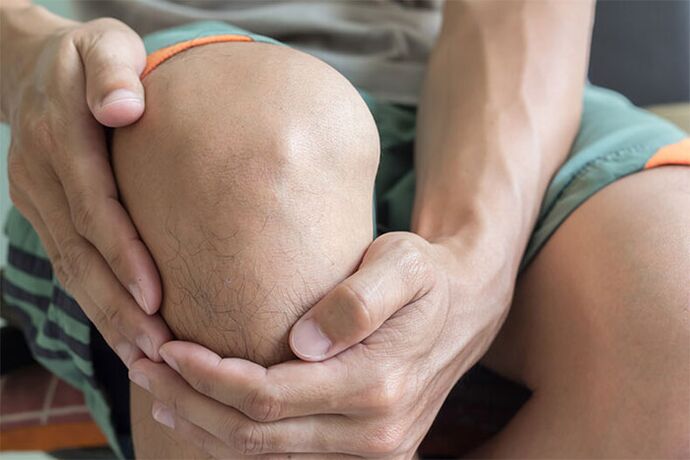
Treatment of pain in the knee joints
Pain in the knees can be divided into those that require emergency medical care. And those who are pre-diagnosed. Urgent conditions include any injuries, fractures, dislocations, abscesses, purulent inflammation, hemarthrosis (bleeding into the joint). The symptoms are the same in all cases - unbearable pain, swelling, redness, inability to move, fever in the knee joint and fever.
Treatment is limited to first aid until the ambulance arrives:
- the leg should be raised - put on a rolled roller or a hard pillow;
- Put a bandage with ice on the knee and change it every 5-10 minutes.
- take an available pain reliever.
In all other cases, treatment is carried out after a comprehensive examination and research into the causes. Depending on the anamnesis, drug therapy, physiotherapy, exercise therapy, massage, homeopathic treatment, local applications, spa stays and, in extreme cases, an operation are prescribed.
Conservative therapy
Traditional drug treatment for pain includes the following groups of drugs:
- anesthetics. To relieve the first symptoms and relieve the painful condition, you can take simple over-the-counter painkillers. Severe cases associated with loss of mobility and excruciating pain require more serious medications that are only prescribed by a doctor and are available by prescription.
- NSAIDs. Quickly helps with inflammation and swelling.
- chondroprotectors. Despite the long course of administration, modern drugs ensure regeneration of cartilage tissue. The effect is cumulative and long-lasting (up to 10 years, joint pain can not bother after a six-month course, subject to treatment in the early stages).
- glucocorticosteroids. Indicated for patients with autoimmune pathologies to reduce the production of the hormone cortisol and stop the progression of the disease. Dosage and therapy are prescribed strictly individually by the doctor.
- immunosuppressants. They suppress the abnormal effect of the immune system and thereby stabilize the course of dangerous diseases such as rheumatoid arthritis, lupus erythematosus and vasculitis. They are rarely prescribed, only in the event of an accurate diagnosis and the inability to otherwise eliminate knee pain.
- Injections with hyaluronic acid. They are injected directly into the cavity of the knee joint and eliminate pain and lack of synovial fluid. They also help restore hyaline cartilage, thus restoring knee mobility.
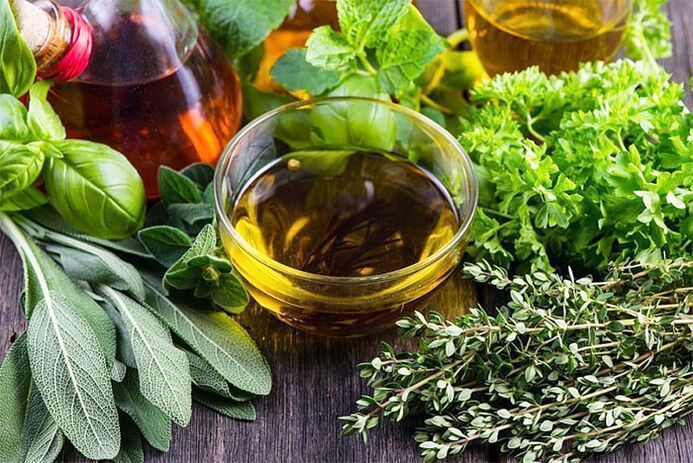
folk recipes
Most people who begin to experience pain in the knee joint try to eliminate discomfort using folk methods. You can make lotions, compresses and nightly applications based on homemade ointments or tinctures. A decoction of herbs and alcohol tinctures for topical use will help prevent a period of exacerbation and relieve obsessive pain.
The following plants and substances have an anti-inflammatory effect:
- mother and stepmother;
- Johannis herbs;
- oak bark;
- burdock root;
- bay leaves;
- chamomile flowers;
- marigold;
- White and Black Kaolin Clay;
- A solution of salt and soda;
- honey products.
For example, mix 10 previously crushed aspirin tablets and a glass of liquid honey. Apply a thick layer to the knee in the area of \u200b\u200bthe pain localization. Cover with cling film and wrap with wool (scarf), preferably leave overnight. The pain is eliminated after the first application.
In the same way, you can apply a clay application where there is pain. Some olive oil is added to the clay-water mixture to prevent the skin from hardening and becoming tense.
An effective recipe that includes honey, salt and soda. Mix 1 teaspoon of salt and soda with honey in an amount sufficient to generously coat the knee joint. This method performs three actions at once - removes excess fluid, relieves inflammation and pain, enriches itself with nutrients.
Oak bark in the form of a decoction or alcohol tincture strengthens blood vessels well and promotes normal blood circulation. For a decoction, pour 1 tablespoon of dried bark with 1 cup of boiled water and boil in a water bath for 20 minutes. Soak gauze with decoction and apply to the knee in a warm (not hot) form for 30-50 minutes to eliminate pain in the knee joint. For alcohol tincture, use the same proportions, just replace water with vodka. Insist in a dark, cool place for 10-14 days. Apply in the same way.
Alternating various means and methods, you can keep the disease for a long time and forget about pain and swelling. The effectiveness of alternative medicine has not been proven, despite the elimination of the main symptoms - pain in the knees.
Massage and therapeutic exercises for pain in the knee joints
A comprehensive traditional treatment necessarily includes exercise therapy and massage. Exercises are recommended to all people who have had or have knee injuries, who have been diagnosed with arthritis, arthrosis and other joint diseases, and who lead an inactive lifestyle (sedentary static work, disability of 1-2 groups, housewives, etc. ).
Gymnastics can be performed independently, at a slow pace and in a workable mode. Gradually increase the number of exercises or, conversely, reduce them, depending on how you feel.
- From a lying position or sitting in a chair, slowly bend and bend your legs until a state of easy fatigue occurs.
- Bend the leg at the knee, perform rotational movements of a small amplitude, repeat the same on the second leg.
- Lying on your back, gently pull your legs, bent at the knees, towards your stomach.
- Put a pillow on the chair and sit so that the legs "dangle", perform circular movements in a clockwise direction and vice versa.
- Sitting on a chair, slowly straighten the leg and hold it in this position for 2-5 seconds, lowering it just as slowly, repeat on the second leg.
- Stand straight, straighten your back, slowly bend your leg at the knee and remain in the "heron" position for a few seconds. Increase the delay time every 2 days if possible.
- If there are no contraindications and health allows, you can complicate the complex. Set the exercise stick to the maximum height that can be reached with one leg bent at the knee. Throw the leg over the "barrier" 10-15 times, then change position.
- A small complex for stretching the lower leg also contributes to the rapid recovery of the knee joint. Lean your palms against the wall, bend your right leg at the knee, put your left leg back. The feet rest completely on the ground. Hold the pose for 30 seconds. switch legs
Regularly performing simple gymnastics, which is accessible to any person, will bring visible results within a month - pain in the knee joint will cease to bother, joint mobility will improve, puffiness will go away.
The effectiveness of gymnastics will be significantly increased if you combine it with a massage course. It can be both a traditional method of exposure and manual pain therapy. It should only be remembered that only experienced professionals with good recommendations should be trusted to conduct such procedures. Otherwise, manual manipulations, at best, will not have the slightest effect, at worst, they will provoke joint displacement and aggravate the pathological condition. Massage should be done regularly, no more than 10 sessions, 25-30 minutes per month. Daily procedures are strictly contraindicated. There should be no pain in the knee during the session. If discomfort is felt, the procedure should be canceled.
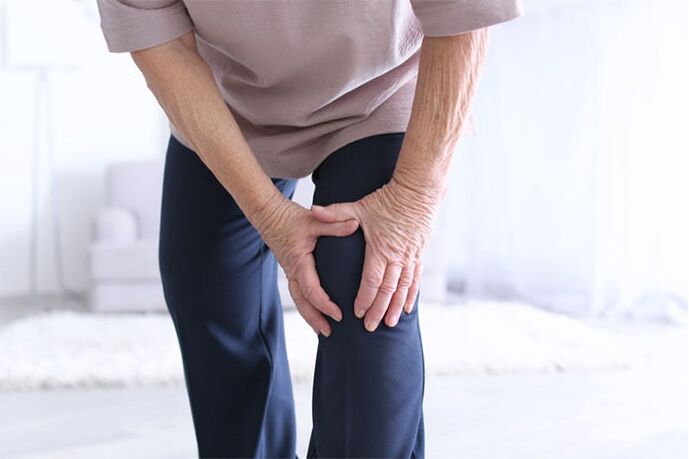
treatment at home
Treating knee pain at home is a prerequisite for outpatient therapy. The patient should help himself using all permissible methods to relieve pain and recover as soon as possible.
Therefore, for these purposes, it is necessary to adhere to some rules for the treatment of all types of pain:
- Follow all the recommendations of the attending physician - do not miss taking prescribed medications, do feasible gymnastics, come to physiotherapy on time.
- Check your diet. Include plenty of fresh vegetables, herbs, and fruits in your diet. Exclude fatty meat, fried foods and semi-finished products.
- If necessary, use tools to relieve the knee joint - walking stick, crutch and other special devices.
- Do not use, without prior consultation with a doctor, prescriptions of traditional medicine, even well-tried and neighbors. What helps one may be categorically contraindicated for another.
- If possible, avoid physical activity during the treatment period and ensure bed rest so that the pain does not return (exception: remedial gymnastics).
- Provide a comfortable place to sleep and rest – orthopedic mattresses, comfortable chairs and armchairs, preferably with small stands so you can comfortably elevate your aching legs.
- Light self-massage is allowed. Stroking, rubbing promotes blood circulation and thus enriches the tissue with oxygen. Thus, muscle spasms are eliminated and the pain becomes less intense.
Precautions
It is almost impossible to fully insure injuries, sprains or dislocations of the most stressed joint in the body. Everyday life forces you to do housework, go to work, etc. In the course of normal activities, it is quite possible to sustain an unexpected injury. But reducing the risk of developing joint disease is well within everyone's power. Leading rheumatologists have developed a number of recommendations that will help you protect yourself from dangerous pathologies:
- Establish a rational regime and strictly observe it - work-rest. This is especially true for people whose activities are associated with increased physical activity (athletes, builders, sellers, metallurgists, miners, etc. ).
- Timely treatment and rehabilitation after infectious diseases. This rule also applies to such "harmless" as acute respiratory infections or seasonal SARS.
- Avoid low temperatures, drafts. Dress appropriately for the weather to avoid hypothermia.
- Upon reaching the age of 35, it is desirable to undergo treatment with chondroprotectors.
- Monitor your weight carefully. An increase in body weight inevitably increases the load on the knees. This is something to keep in mind when eating another bun.
- Adhere to the principles of healthy eating to keep the weight normal. More vegetables and dairy - less sweet, spicy, salty, fatty and starchy foods.
- Reconsider your lifestyle – giving up smoking, alcohol and other toxic addictions not only has a positive effect on your knee joints, but also on life in general. To overcome addiction, you can turn to your relatives - the difficult period will pass much faster and easier.
Everyone has pain in the knee joints, regardless of age, gender or social status. From the very first steps, the joint is subjected to all sorts of tests - falls, bruises, injuries, sports, hypothermia. Nevertheless, many people manage to maintain the mobility, health and functionality of the main building into old age.

























